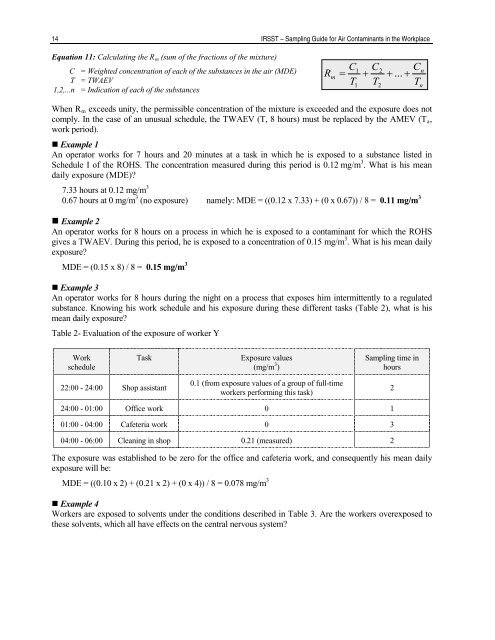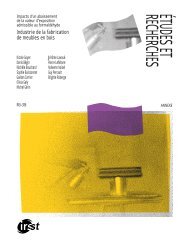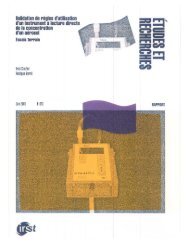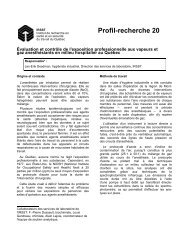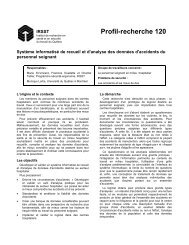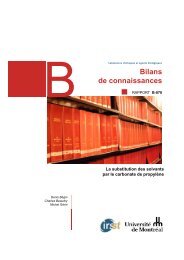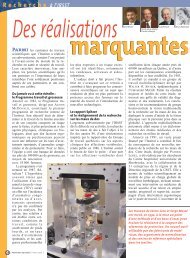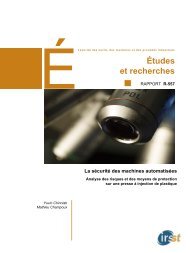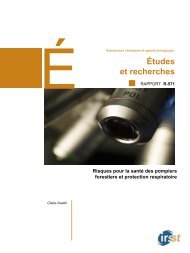Sampling Guide for Air Contaminants in the Workplace - Irsst
Sampling Guide for Air Contaminants in the Workplace - Irsst
Sampling Guide for Air Contaminants in the Workplace - Irsst
Create successful ePaper yourself
Turn your PDF publications into a flip-book with our unique Google optimized e-Paper software.
14 IRSST – <strong>Sampl<strong>in</strong>g</strong> <strong>Guide</strong> <strong>for</strong> <strong>Air</strong> <strong>Contam<strong>in</strong>ants</strong> <strong>in</strong> <strong>the</strong> <strong>Workplace</strong><br />
Equation 11: Calculat<strong>in</strong>g <strong>the</strong> R m (sum of <strong>the</strong> fractions of <strong>the</strong> mixture)<br />
C = Weighted concentration of each of <strong>the</strong> substances <strong>in</strong> <strong>the</strong> air (MDE)<br />
T = TWAEV<br />
1,2,...n = Indication of each of <strong>the</strong> substances<br />
C1<br />
C2<br />
C<br />
R<br />
m<br />
= + + ... +<br />
T T T<br />
1<br />
2<br />
n<br />
n<br />
When R m exceeds unity, <strong>the</strong> permissible concentration of <strong>the</strong> mixture is exceeded and <strong>the</strong> exposure does not<br />
comply. In <strong>the</strong> case of an unusual schedule, <strong>the</strong> TWAEV (T, 8 hours) must be replaced by <strong>the</strong> AMEV (T a ,<br />
work period).<br />
• Example 1<br />
An operator works <strong>for</strong> 7 hours and 20 m<strong>in</strong>utes at a task <strong>in</strong> which he is exposed to a substance listed <strong>in</strong><br />
Schedule I of <strong>the</strong> ROHS. The concentration measured dur<strong>in</strong>g this period is 0.12 mg/m 3 . What is his mean<br />
daily exposure (MDE)?<br />
7.33 hours at 0.12 mg/m 3<br />
0.67 hours at 0 mg/m 3 (no exposure) namely: MDE = ((0.12 x 7.33) + (0 x 0.67)) / 8 = 0.11 mg/m 3<br />
• Example 2<br />
An operator works <strong>for</strong> 8 hours on a process <strong>in</strong> which he is exposed to a contam<strong>in</strong>ant <strong>for</strong> which <strong>the</strong> ROHS<br />
gives a TWAEV. Dur<strong>in</strong>g this period, he is exposed to a concentration of 0.15 mg/m 3 . What is his mean daily<br />
exposure?<br />
MDE = (0.15 x 8) / 8 = 0.15 mg/m 3<br />
• Example 3<br />
An operator works <strong>for</strong> 8 hours dur<strong>in</strong>g <strong>the</strong> night on a process that exposes him <strong>in</strong>termittently to a regulated<br />
substance. Know<strong>in</strong>g his work schedule and his exposure dur<strong>in</strong>g <strong>the</strong>se different tasks (Table 2), what is his<br />
mean daily exposure?<br />
Table 2- Evaluation of <strong>the</strong> exposure of worker Y<br />
Work<br />
schedule<br />
Task<br />
Exposure values<br />
(mg/m 3 )<br />
<strong>Sampl<strong>in</strong>g</strong> time <strong>in</strong><br />
hours<br />
22:00 - 24:00 Shop assistant<br />
0.1 (from exposure values of a group of full-time<br />
workers per<strong>for</strong>m<strong>in</strong>g this task)<br />
2<br />
24:00 - 01:00 Office work 0 1<br />
01:00 - 04:00 Cafeteria work 0 3<br />
04:00 - 06:00 Clean<strong>in</strong>g <strong>in</strong> shop 0.21 (measured) 2<br />
The exposure was established to be zero <strong>for</strong> <strong>the</strong> office and cafeteria work, and consequently his mean daily<br />
exposure will be:<br />
MDE = ((0.10 x 2) + (0.21 x 2) + (0 x 4)) / 8 = 0.078 mg/m 3<br />
• Example 4<br />
Workers are exposed to solvents under <strong>the</strong> conditions described <strong>in</strong> Table 3. Are <strong>the</strong> workers overexposed to<br />
<strong>the</strong>se solvents, which all have effects on <strong>the</strong> central nervous system?


